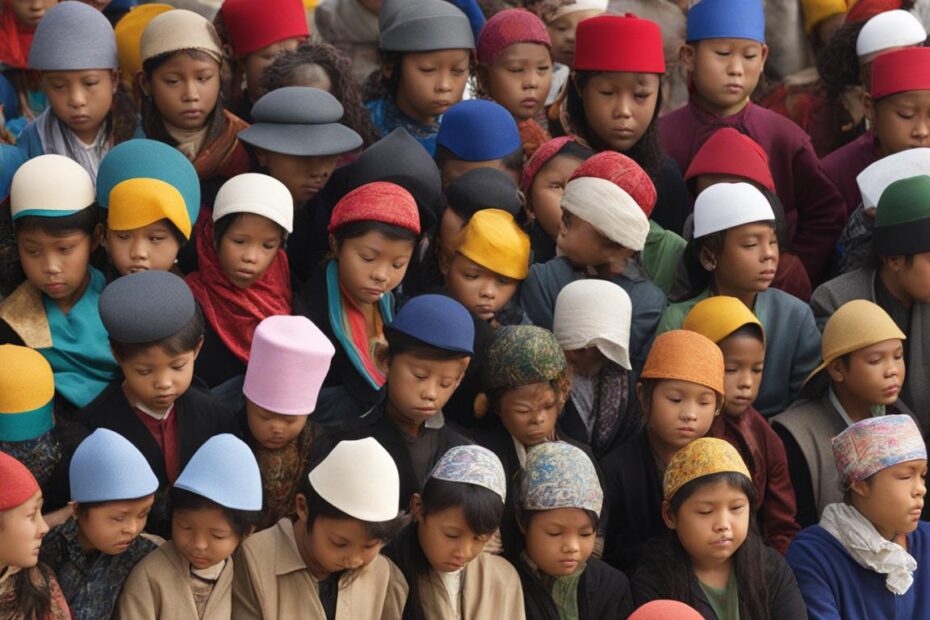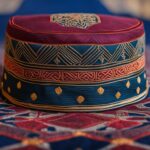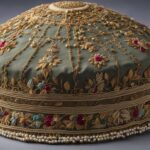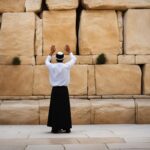The history of the prayer cap is a fascinating journey through time. It has deep cultural and religious significance in American heritage. The origin of the prayer cap can be traced back to the late 1800s when women began wearing prayer caps and bonnets. The practice of wearing a prayer cap was emphasized in Anabaptist congregations, particularly among Mennonite women. The head covering was viewed as a symbol of prayer and humility, following the biblical command in 1 Corinthians 11. The prayer cap became associated with the Anabaptist tradition and was seen as a way to separate themselves from the changing fashion trends of the time. Over the years, the style and design of prayer caps have evolved, but they have remained a constant symbol of devotion and religious identity.
Key Takeaways:
- The prayer cap has a rich history dating back to the late 1800s.
- It was primarily worn by women in Anabaptist congregations.
- The prayer cap symbolizes prayer, humility, and religious identity.
- Over time, the style and design of prayer caps have evolved.
- Prayer caps remain an enduring symbol of devotion and religious traditions.
The Evolution of Prayer Caps
The prayer cap has undergone various changes throughout history, reflecting cultural shifts and personal preferences. In the late 1800s, prayer caps were commonly worn both inside and outside of the church. However, as the 20th century progressed, wearing prayer caps outside of religious settings began to decline, and they became more synonymous with Mennonite women and other Anabaptist groups. Today, prayer caps can be found in various shapes, sizes, and materials, reflecting the diverse preferences of those who wear them.
To understand the evolution of prayer caps, it’s important to consider the historical significance they hold. Originally, prayer caps were a symbol of devotion and modesty, following the biblical command in 1 Corinthians 11. They were a way for individuals to separate themselves from changing fashion trends and adhere to religious customs. As time went on, the style and design of prayer caps changed to adapt to societal changes while still maintaining their religious significance.
“The style and design of prayer caps also changed over time, reflecting cultural shifts and personal preferences.”
Today, prayer caps are not only worn as a religious practice but also as a personal choice. Some individuals choose to wear prayer caps as a way to express their faith and commitment to their religious beliefs. Others may wear them as a cultural or familial tradition, finding deeper meaning and connection to their spirituality through this practice. Regardless of the reasons behind wearing a prayer cap, they continue to hold great cultural and religious significance for those who embrace them.
The Evolution of Prayer Caps
| Era | Characteristics |
|---|---|
| Late 1800s | Prayer caps commonly worn both inside and outside of the church |
| 20th century | Decline in wearing prayer caps outside of religious settings; synonymous with Mennonite women and Anabaptist groups |
| Present day | Prayer caps found in various shapes, sizes, and materials, reflecting personal preferences |
Through the evolution of prayer caps, we can see the enduring cultural and religious significance they hold. They are not only a symbol of devotion and humility but also serve as a way for individuals to express their religious identity. The changing styles and designs of prayer caps reflect the ever-changing world while maintaining a connection to tradition and faith. Whether worn as a religious practice or a personal choice, prayer caps continue to be an important part of religious and cultural expression.
The Cultural and Religious Significance of Prayer Caps
Prayer caps hold deep cultural and religious significance, serving as more than just a fashion accessory. These head coverings symbolize religious identity and devotion, carrying great meaning within various traditions. In the Anabaptist tradition, for example, wearing a prayer cap is an act of modesty, humility, and submission to God. It is a visible reminder of one’s commitment to a pious life, helping individuals distinguish themselves from the secular world and adhere to religious customs and traditions.
The significance of prayer caps extends beyond the Anabaptist tradition, becoming part of the rich tapestry of head covering traditions across different cultures and religions. They symbolize reverence and respect for the divine, acting as a tangible representation of faith and spirituality. Whether woven from fine fabrics or crafted modestly, prayer caps are a testament to the commitment and devotion of those who wear them.
Prayer caps are not merely pieces of clothing; they carry with them the weight of centuries of tradition and the depth of personal conviction.
Throughout history, traditional head coverings have played a role in religious communities. From the prayer caps of the Anabaptists to the hijabs worn by Muslim women, head coverings are deeply intertwined with religious beliefs and practices. Each tradition brings its unique customs and interpretations, but undeniably, prayer caps are important symbols of religious dedication and expression.
As we explore the cultural and religious significance of prayer caps, we gain a deeper understanding of the diverse ways individuals connect with their spirituality. These head coverings, rooted in history and faith, continue to hold a place of honor and reverence in the lives of those who embrace them.
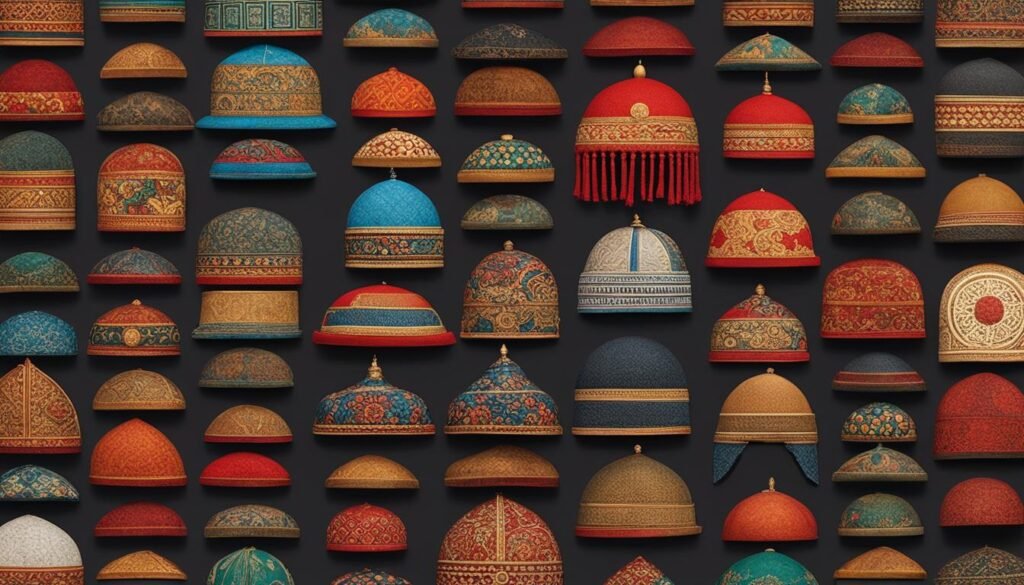
Table: Comparison of Prayer Caps in Different Religious Traditions
| Religion | Prayer Cap Name | Symbolism |
|---|---|---|
| Christianity (Anabaptist) | Prayer Cap | Modesty, devotion, and separation from the secular world |
| Islam | Hijab | Modesty, piety, and obedience to religious teachings |
| Judaism | Kippah/Yarmulke | Humility, respect for God, and adherence to religious laws |
| Sikhism | Turban | Identity, spirituality, and equality |
| Hinduism | Pagri | Religious devotion, honor, and social status |
Personal Experiences with the Prayer Cap
Personal experiences with prayer caps vary greatly, as they are deeply personal and can have a significant impact on an individual’s spiritual journey. For some, wearing a prayer cap is a lifelong commitment, a visible sign of their faith and dedication to religious principles. It becomes a part of their identity and a source of inspiration and strength.
One individual, Mary Johnson, shares her story of how the prayer cap has influenced her life:
“Wearing the prayer cap has always been a part of my family’s tradition. My mother and grandmother wore it, and so did I. Initially, I wore it out of respect for my family and to uphold our cultural heritage. However, as I grew older, I realized that the prayer cap was more than just a tradition. It became a symbol of my faith and a reminder of my connection to God. Whenever I wore the cap, I felt a sense of peace and tranquility. It became a spiritual practice for me, a way to center myself and focus on prayer.”
Another individual, David Martinez, found a deeper connection to his spirituality through wearing a prayer cap:
“When I started wearing the prayer cap, I saw it as simply a religious garment. However, as time passed, I began to experience a sense of reverence and humility whenever I wore it. It became a constant reminder of my commitment to living a pious life and seeking a closer relationship with God. Wearing the cap helped me to internalize the values and teachings of my faith and integrate them into my daily life.”
These personal stories highlight the profound impact that prayer caps can have on one’s spiritual journey. Each experience is unique and reflects the individual’s quest for deeper meaning and connection to their faith. It is through personal experiences like these that we gain a deeper understanding of the significance of prayer caps as a powerful symbol of devotion and religious identity.
Table: Comparative Analysis of Personal Experiences with Prayer Caps
| Participants | Reason for wearing prayer cap | Impact on spiritual journey |
|---|---|---|
| Mary Johnson | Family tradition and cultural heritage | Sense of peace, tranquility, and connection to God |
| David Martinez | Religious commitment and seeking a closer relationship with God | Internalization of faith values and integration into daily life |
Conclusion
The prayer cap has a captivating history that spans centuries and holds immense cultural and religious significance. Originating in the late 1800s, prayer caps were worn by women as a symbol of prayer and humility, particularly in Anabaptist congregations. These head coverings allowed individuals to separate themselves from the fashion trends of the time and express their devotion to God.
Throughout the years, prayer caps have evolved in style and design, reflecting cultural shifts and personal preferences. While their popularity outside of religious settings has declined, prayer caps remain an integral part of the attire for Mennonite women and other Anabaptist groups, representing devotion and modesty.
The cultural and religious significance of prayer caps extends beyond their aesthetic appeal. These head coverings serve as tangible reminders of one’s commitment to living a pious life and adhering to religious customs and traditions. They symbolize humility, submission to God, and reverence for the divine. Prayer caps have become woven into the fabric of various cultures and religions, enriching the diverse tapestry of head covering traditions.
Personal experiences with prayer caps highlight their profound influence on individuals’ spiritual journeys. For many, wearing a prayer cap is not only a visual representation of their faith but also a source of inspiration and strength. Each personal story reveals the deep connection and meaning that prayer caps hold, solidifying their place as cherished symbols of devotion and religious identity.
FAQ
What is the history of the prayer cap?
The history of the prayer cap dates back to the late 1800s when women began wearing prayer caps and bonnets. It has deep cultural and religious significance, particularly in the Anabaptist tradition.
How has the style and design of prayer caps evolved over time?
Prayer caps have undergone various changes throughout history, reflecting cultural shifts and personal preferences. Today, they can be found in various shapes, sizes, and materials, but they still hold great significance for those who wear them.
What is the significance of prayer caps in religious traditions?
Prayer caps are seen as a way to demonstrate modesty, humility, and submission to God. They symbolize devotion and act as a tangible reminder of one’s commitment to living a pious life.
What are personal experiences with prayer caps?
Many individuals have personal experiences with prayer caps and how they have influenced their lives. For some, wearing a prayer cap is a lifelong commitment, while others may have discovered deeper meaning and connection to their spirituality through this practice.
What is the enduring significance of the prayer cap?
The prayer cap has played a crucial role in shaping religious identity and expressing devotion to God throughout history. Its evolution reflects the changing times and cultural shifts while remaining a symbol of tradition and faith.


